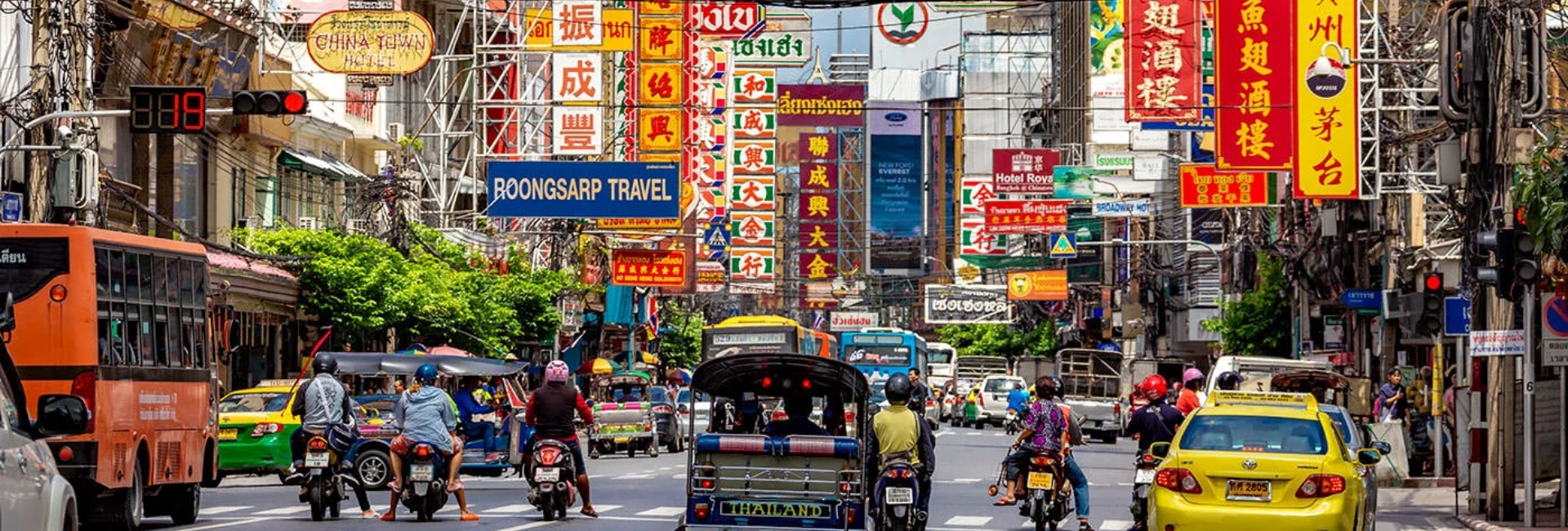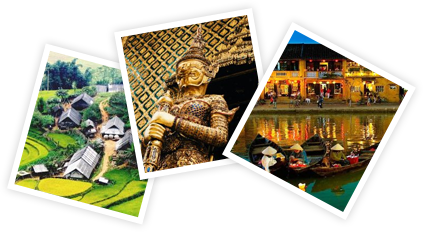Among Bangkok, a city of contrasts, where ancient traditions blend seamlessly with modern developments, there is the most vibrant districts is Chinatown, a cultural melting pot that has been shaping the city’s identity for centuries. If you’re planning a trip to Bangkok this year, this comprehensive guide will help you navigate one of the city’s most exciting neighborhoods and understand why it deserves a spot on your itinerary.
What is China Town in Bangkok?
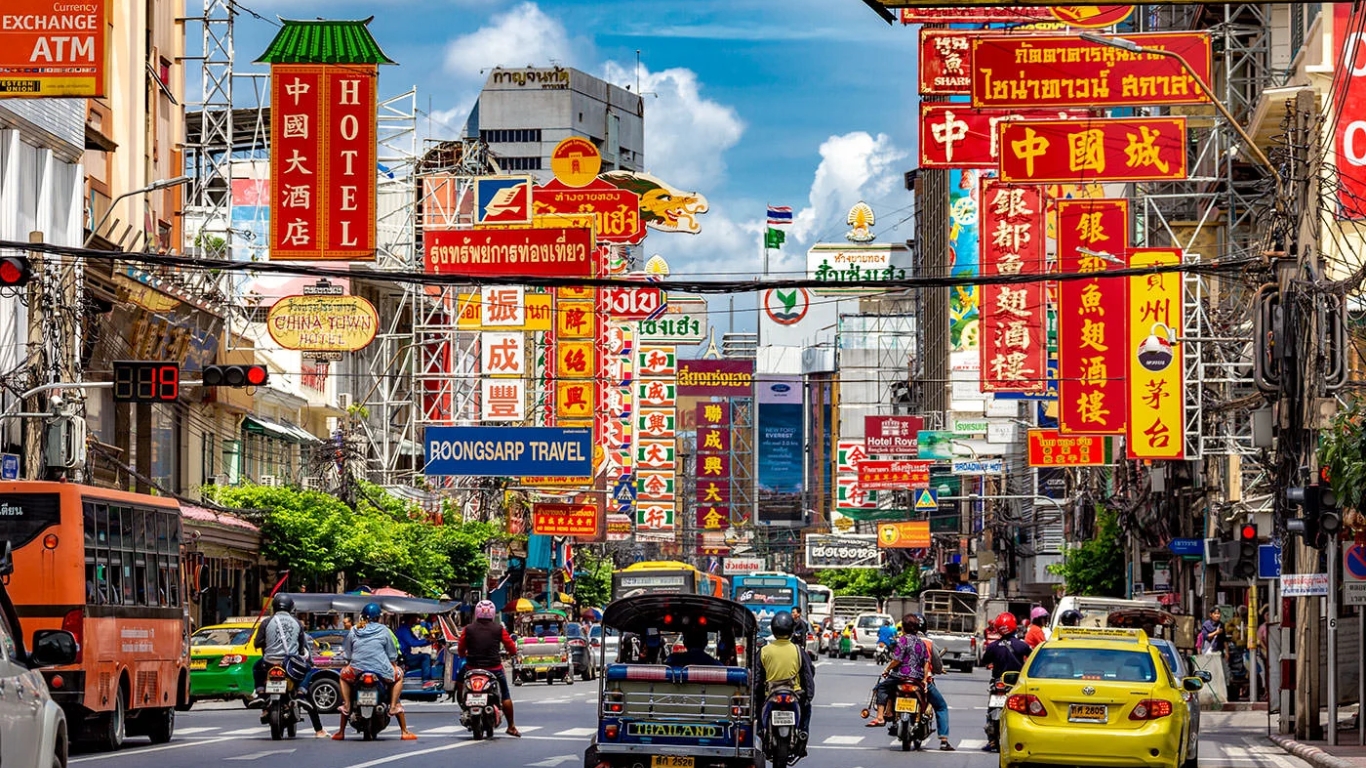
China Town in Bangkok Thailand, locally known as Yaowarat, is one of the largest and oldest Chinatowns in the world. Established in 1782 when Bangkok became the capital of the Rattanakosin Kingdom, it served as the new home for the Teochew Chinese immigrants who were relocated from their original settlement near the Grand Palace area.
Located in the Samphanthawong District along the east bank of the Chao Phraya River, Chinatown spans a vast area with Yaowarat Road serving as its main artery. This 1.5-kilometer road weaves through the neighborhood in a dragon-like pattern, giving the area part of its distinctive character.
What makes Bangkok’s Chinatown special is its authentic preservation of Chinese heritage within Thai culture. Unlike many Chinatowns around the world that have become primarily tourist attractions, Bangkok’s Chinatown remains a living, breathing commercial center where local Chinese-Thai communities continue their centuries-old traditions.
When you visit Chinatown, you’ll immediately notice the distinctive architecture featuring Chinese-style shophouses adorned with red lanterns and gold accents. The narrow alleyways are packed with vendors selling everything from traditional Chinese medicines and religious items to modern electronics and fashion. The air is filled with the tantalizing aromas of street food stalls serving both Chinese and Thai delicacies.
Chinatown truly comes alive during Chinese festivals such as Chinese New Year (typically in January or February) and the Vegetarian Festival (around October), when the streets are decorated with colorful ornaments and buzzing with cultural performances. These celebrations offer a unique glimpse into the harmonious blending of Chinese traditions with Thai culture.
Beyond its commercial significance, Bangkok’s Chinatown is also a place of religious diversity. Here you’ll find Buddhist temples of both Theravada and Mahayana traditions, Christian churches, Muslim mosques, and numerous Chinese shrines dedicated to various deities, all coexisting within a few blocks of each other.
>> Read more: Discover Hidden Gems: 9 Unusual Things To Do in Bangkok & Travel Guide
What you can do in this town?
Bangkok’s Chinatown offers a sensory overload of experiences that will delight travelers seeking authentic cultural immersion. From culinary adventures to historical explorations, there’s something for everyone in this vibrant district.
Explore the diversity of cuisine between China and Thailand
- Open time: Food stalls typically open from late afternoon (around 4 PM) until midnight; restaurants from 10 AM to 10 PM
- Cost: Street food from 40-150 baht per dish; restaurant meals from 150-500 baht per person
- Suitable for: Food enthusiasts, culinary adventurers, and anyone who loves authentic flavors
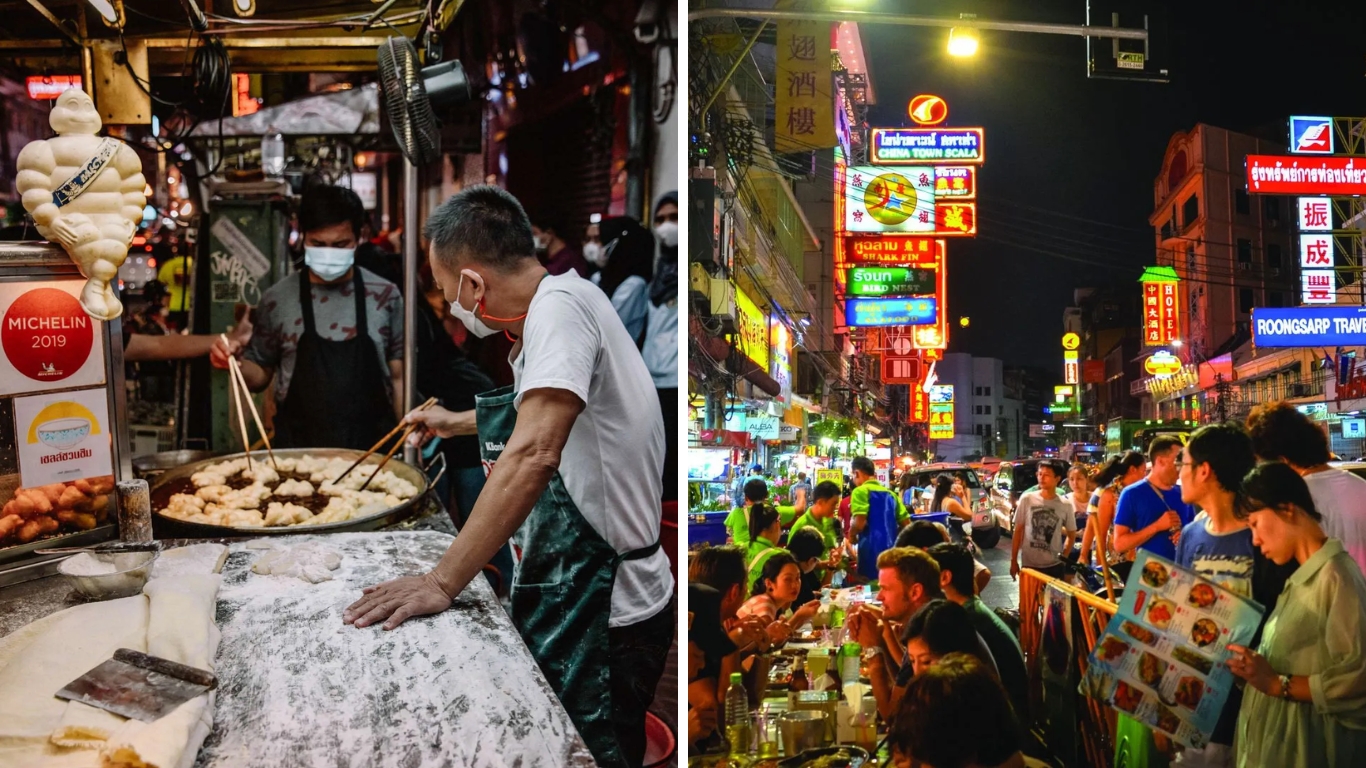
Yaowarat Road transforms into a food paradise after sunset, with countless stalls and restaurants serving some of the most delicious dishes in Bangkok. The seafood options are particularly outstanding, with stir-fried crab, sweet and sour shrimp, and shark fin soup being local specialties. Follow the crowds of locals to find the best spots – Fai-Kaew Yao Wa-Rat is one such famous seafood stall where the chef puts on a show by shooting flames high into the air while cooking.
Don’t miss the opportunity to try Chinese-Thai fusion dishes that you won’t find elsewhere. The area is also famous for its unique desserts, including warm sesame dumplings in ginger tea and freshly grilled bread rolls filled with sweet fillings like custard or chocolate.
For the best food experience, visit during weekday evenings when the crowds are slightly smaller. Bring cash, as many street vendors don’t accept cards, and be prepared to eat standing up or at shared tables. Also, remember that some of the most authentic places might not have English menus, so either bring a translation app or be adventurous and point to what looks good!
Try to bargaining
- Open time: Most markets and shops operate from 9 AM to 6 PM; some wholesale markets open as early as 6 AM
- Cost: Free to browse; purchases depend on your bargaining skills
- Suitable for: Shopping enthusiasts, souvenir hunters, and those looking to practice their negotiation skills
Bargaining is not just a shopping method in Chinatown—it’s a cultural experience. Sampheng Lane (Soi Wanit 1) is the heart of Chinatown’s shopping scene, offering a dizzying array of goods from fabric and clothing to toys and electronics at wholesale prices. Here, haggling is expected and respected as part of the shopping ritual.
When bargaining, start at about 40-50% of the initial asking price and work your way up from there. Maintain a friendly demeanor throughout the process—smiles and good humor will often get you better deals than aggressive negotiation. If you’re buying multiple items from the same vendor, always ask for a bulk discount.
The best bargaining opportunities can be found in the small alleyways branching off from the main roads. Charoen Chai area is particularly notable for traditional Chinese goods including joss paper, festival items, and traditional wedding supplies—possibly the last place in Thailand where these authentic items can be found.
A useful tip: learn a few basic Thai phrases for negotiating. Simple expressions like “Lot noi dai mai?” (Can you reduce a little?) can go a long way. Also, be prepared to walk away if you can’t reach an agreeable price—sometimes the vendor will call you back with a better offer!]
>> Explore Bangkok Night Markets here: Top 10 Best Night Markets in Bangkok – Bargain Tips on Bangkok Street
Lost in Historical Significance in town
- Open time: Temples typically open from 8 AM to 5 PM; museums from 9 AM to 5 PM (often closed on Mondays)
- Cost: Wat Traimit (Golden Buddha Temple): 100-200 baht; Yaowarat Chinatown Heritage Center: 100 baht
- Suitable for: History buffs, culture seekers, architecture enthusiasts
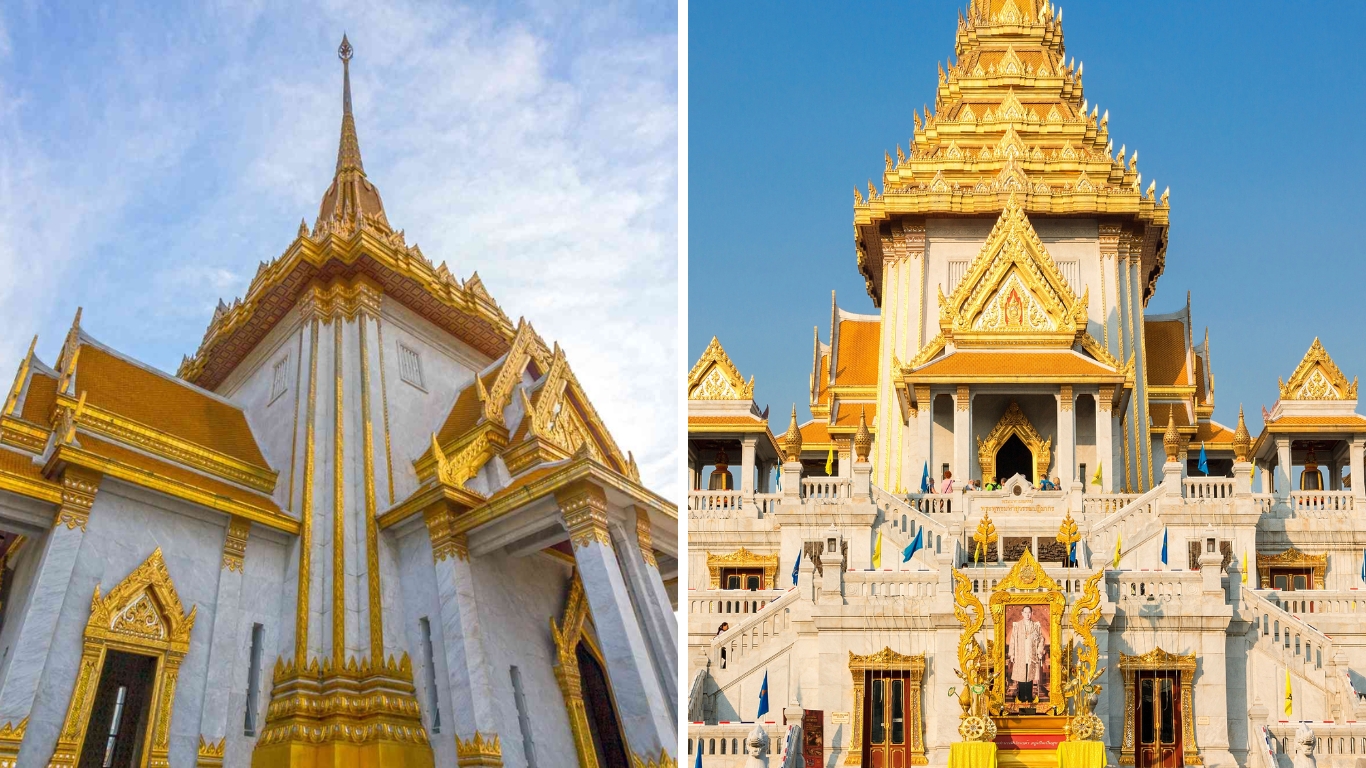
Bangkok’s Chinatown is a living museum where every street corner tells a story of migration, resilience, and cultural fusion. Start your historical journey at Wat Traimit, home to the world’s largest solid gold Buddha statue weighing an impressive 5.5 tons. The temple complex also houses the Yaowarat Chinatown Heritage Center on its second floor, which provides fascinating insights into Chinese migration to Thailand and the development of Chinatown.
Another must-visit historical site is Wat Mangkon Kamalawat (Dragon Lotus Temple), Bangkok’s largest Chinese-Buddhist temple dating back to 1872. This ornate temple offers a glimpse into the religious practices that Chinese immigrants brought with them and how these evolved within the Thai context.
For architecture enthusiasts, Charoen Chai Historical Neighborhood preserves traditional Chinese shophouses that have stood for generations. Many of these buildings maintain their original wooden structures and unique architectural details that are increasingly rare in modern Bangkok.
To enhance your historical exploration, consider visiting during weekday mornings when sites are less crowded. Many historical buildings don’t have obvious signage in English, so downloading a walking tour app or hiring a local guide can provide valuable context to what you’re seeing. Don’t rush through these historical sites—take time to notice the details and cultural significance behind each location.
Depth in “crazy” nightlife
- Open time: Bars and nightlife venues typically open from 6 PM until 1-2 AM
- Cost: Drinks from 150-350 baht; cover charges for some venues: 200-500 baht
- Suitable for: Adult travelers, night owls, photography enthusiasts
When the sun sets, Chinatown transforms from a bustling commercial district into an atmospheric nightlife destination with options ranging from rooftop bars to street-side drinking spots. The area offers a more authentic alternative to Bangkok’s more tourist-oriented nightlife districts.
For breathtaking views, head to Sky View 360° Restaurant on the top floor of the Grand China Hotel. This revolving restaurant provides panoramic vistas of the Chao Phraya River and Bangkok skyline while you enjoy live music and cocktails. Another excellent choice is the River Vibe Restaurant and Bar at River View Guest House, which offers spectacular river views in a more relaxed setting.
For something different, check out El Chiringuito, a Spanish-inspired bar serving sangria and tapas in a unique setting that contrasts wonderfully with the Chinese surroundings. The narrow sois (lanes) off Yaowarat Road also hide several speakeasy-style bars that blend Chinese aesthetics with modern cocktail culture.
Photography enthusiasts will find Chinatown’s nightscape particularly rewarding—the neon signs, illuminated Chinese characters, and bustling street scenes create stunning visual opportunities. For safety, stick to main areas at night and be mindful of your belongings in crowded spaces. Consider joining a group for a nighttime food and drinks tour if you want to discover hidden gems with local expertise.
Strolling around Alleys and Hidden Gems
- Open time: Best explored from morning to late afternoon (9 AM – 5 PM)
- Cost: Free; optional purchases as you explore
- Suitable for: Adventure seekers, photographers, those looking for authentic experiences
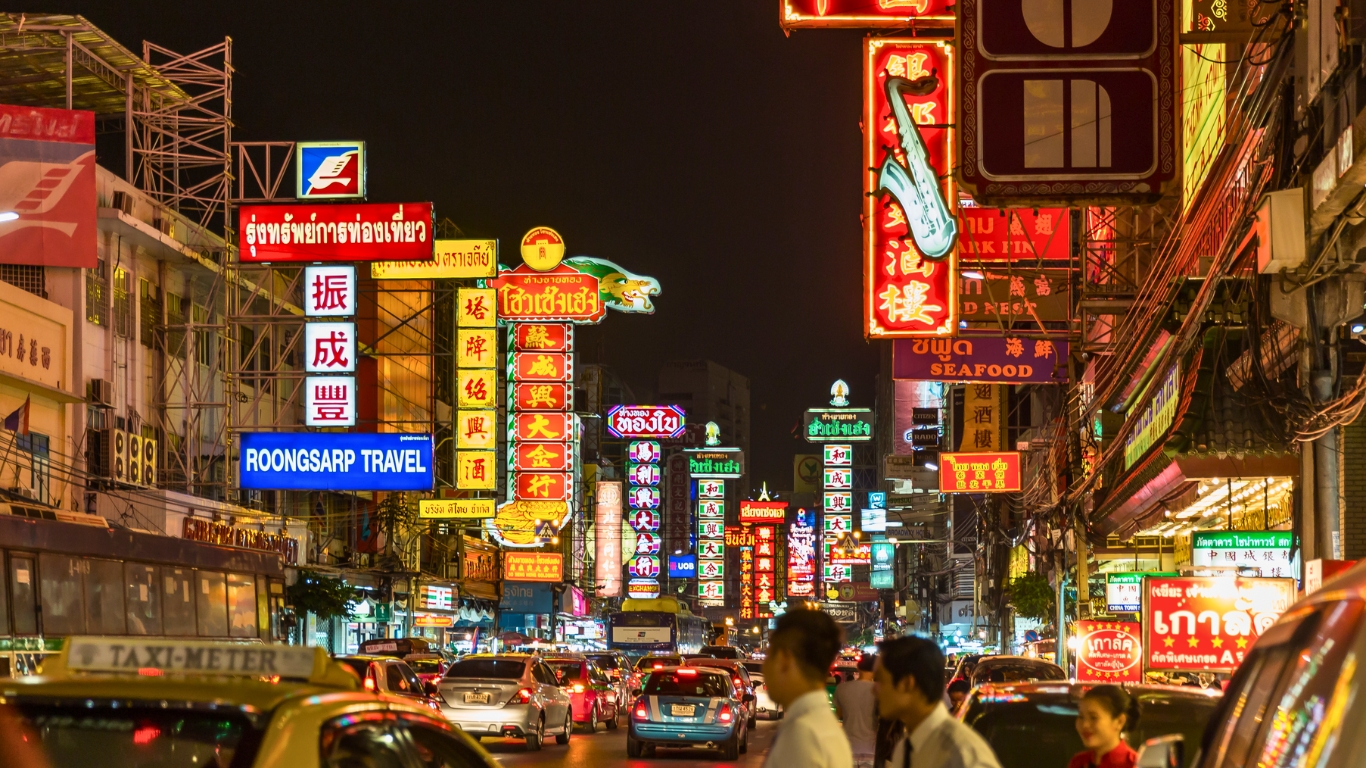
Bangkok’s Chinatown is a labyrinth of narrow alleys, hidden shrines, and secret courtyards that reward curious explorers. Moving away from the main Yaowarat Road reveals a different side of Chinatown where daily life unfolds in fascinating ways.
Talat Noi is one such hidden gem—a fringe neighborhood southeast of Yaowarat that houses several historic buildings and workshops. This area is known for its vintage auto parts shops and traditional craftsmanship, with many businesses continuing practices that have been passed down through generations. The photogenic Holy Rosary Church and Soi San Chao Rong Kueak (with its small Chinese shrine) are highlights of this area.
Song Wat Road, running alongside the Chao Phraya River, offers a glimpse into the area’s trading past. Once lined with bustling cargo piers, today it features beautifully preserved shophouses and small businesses that have operated for decades.
For the best exploration experience, wear comfortable shoes and bring water, as Bangkok’s heat can be intense. Start your wandering early in the morning when temperatures are cooler and the alleyways are less crowded. Consider creating a loose itinerary of a few specific points of interest, but allow plenty of time for spontaneous discoveries—some of Chinatown’s most charming spots are those you stumble upon by chance.
Don’t be afraid to venture down unmarked alleys (during daylight hours), as these often lead to the most authentic experiences. A paper map can be helpful as phone signals can be unreliable in some narrow lanes. If you get lost, locals are generally friendly and willing to point you in the right direction.
How to get there?
Bangkok’s Chinatown is well-connected to the rest of the city through various transportation options, making it accessible for all travelers:
| Transportation | Details |
| By MRT (Subway) | – Take the MRT Blue Line to Wat Mangkon Station. – Exit 1 leads to Charoen Krung Road. – Exit 2 leads to Yaowarat Road. – Alternatively, use Hua Lamphong Station (15-minute walk). |
| By Boat | – Take the Chao Phraya Express Boat to Ratchawong Pier. – Short 5-10 minute walk to Yaowarat Road. – Scenic views of riverside Bangkok. |
| By Taxi or Ride-Hailing | – Request “Yaowarat Road” or “Chinatown Gate.” – Use ride-hailing apps like Grab for precise drop-off. – Convenient for luggage or hot weather. |
| By Tuk-tuk | – Negotiate fare before riding (150-250 baht from central areas). – Offers a quintessential Bangkok experience. |
| By bus | – Various routes (1, 7, 8, 37, 49, 75) pass through or near Chinatown. – Signage and announcements primarily in Thai, can be challenging for non-Thai speakers. |
| On foot | – Walk from the old town (Rattanakosin) area. – Approximately 30-minute walk from the Grand Palace, allowing exploration of historic districts. |
When planning your visit, remember that traffic in central Bangkok can be extremely congested, especially during rush hours (7-9 AM and 4-7 PM). The MRT is generally the most reliable option during these times. If you’re visiting multiple areas in one day, consider combining your Chinatown visit with nearby attractions like the Grand Palace, Wat Pho, or the flower market at Pak Khlong Talat to maximize your time and minimize transportation hassles.
Any fact further more?
Here are some fascinating facts and helpful insights about Bangkok’s Chinatown that will enhance your visit:
- Bangkok’s Chinatown is considered one of the largest Chinatowns in the world, spanning an area that roughly coincides with the entire Samphanthawong District.
- The Chinese community in Bangkok was originally settled near the Grand Palace area but was forced to relocate when King Rama I established the new capital in 1782. The relocation was partly politically motivated, as the Teochew Chinese had been supporters of the previous ruler, King Taksin.
- The main road in Chinatown, Yaowarat Road, wasn’t built until 1891 during the reign of King Rama V (Chulalongkorn). Before that, the narrow Sampheng Lane was the only thoroughfare.
- The iconic Chinatown Gate (China Gate) is a relatively recent addition, having been erected in 1999. The Chinese characters on the gate say “Sheng Shou Wu Jiang,” which means “Long Live the King.”
- During the Vegetarian Festival (typically held in October), many restaurants and food stalls in Chinatown switch to serving exclusively vegetarian food, identified by yellow flags with red Chinese characters.
- The gold shops along Yaowarat Road are known for offering some of the best gold prices in Thailand. Many Thai people prefer to buy their gold jewelry in Chinatown rather than in shopping malls.
- Sampheng Lane was once notorious as a red-light district in the early 20th century, hosting opium dens, gambling houses, and brothels. Today, it’s transformed into a wholesale shopping paradise.
- The best time to visit Chinatown for food is between 6 PM and 10 PM when most food stalls are open. However, many shops close on Mondays, and some close during Chinese New Year celebrations.
- Bangkok’s Chinatown experienced several devastating fires during the 19th century, which actually helped modernize the area as new roads were built in the aftermath.
- The area is home to some of Bangkok’s oldest pharmacies, where traditional Chinese medicine is still practiced and sold alongside modern pharmaceuticals.
- Many of the buildings in Chinatown feature hidden shrines on upper floors or in back rooms, continuing centuries-old traditions of ancestor worship and deity reverence.
- During Chinese New Year, it’s customary for Thai politicians and celebrities to make appearances in Chinatown, highlighting its cultural and political significance within Thailand.
FAQs
Is Chinatown in Bangkok a good place to stay?
Staying in Chinatown offers an authentic, immersive experience in one of Bangkok’s most culturally rich neighborhoods. The area has a growing number of boutique hotels, many in beautifully renovated historic buildings. Advantages include proximity to amazing food options, 24-hour activity, and good connections to attractions via the MRT Wat Mangkon station. However, be aware that streets can be noisy until late at night, and some accommodations in older buildings might lack modern amenities. Chinatown is ideal for food enthusiasts, culture seekers, and those who enjoy vibrant street life, but might not suit travelers looking for quiet luxury or modern high-rise accommodations.
What is the famous street in Chinatown Bangkok?
Yaowarat Road is unquestionably the most famous street in Bangkok’s Chinatown. This 1.5-kilometer thoroughfare serves as the main artery of the district and is often referred to as the “backbone of Chinatown.” Its dragon-like shape, weaving through the neighborhood, is symbolic of Chinese culture. Yaowarat Road is particularly known for its dazzling gold shops by day and its transformation into a food paradise by night, with countless street food vendors setting up along the sidewalks. The road becomes especially vibrant after sunset when neon signs illuminate the street, creating the iconic Chinatown atmosphere that appears in countless photographs and films about Bangkok.
Is Chinatown Bangkok open every day?
Chinatown as a district is accessible every day, but individual businesses follow different operating schedules. Most street food vendors operate daily from late afternoon until midnight, with the busiest periods being Friday through Sunday. Retail shops typically open from 9 AM to 6 PM, though many close on Mondays. Gold shops generally operate daily but might close early on Sundays. Temples and cultural sites usually open daily from 8 AM to 5 PM. Be aware that during major Chinese festivals, particularly Chinese New Year, many family-owned businesses close for several days for celebrations. The area is generally most active Tuesday through Sunday, with slightly reduced activity on Mondays when some wholesalers take their weekly day off.
Which station is Chinatown Bangkok?
Wat Mangkon Station on the MRT Blue Line is the primary station serving Bangkok’s Chinatown. Opened in 2019 as part of the MRT extension, this station was specifically designed to provide convenient access to the Chinatown district. The station’s design incorporates Chinese architectural elements to reflect the cultural heritage of the area. Exit 1 leads toward Charoen Krung Road, while Exit 2 is closest to Yaowarat Road and the heart of Chinatown. Alternatively, Hua Lamphong Station (the former terminus of the Blue Line) is approximately a 15-minute walk from the eastern edge of Chinatown and may be convenient for those also visiting the Bangkok Railway Station in the same trip.
Bangkok’s Chinatown is a vibrant testament to the city’s rich cultural exchange, offering authentic experiences that engage all your senses—from the enticing aromas of street food to the stunning sights of shrines and shophouses. This district uniquely blends tradition with modernity, with centuries-old family businesses coexisting alongside trendy cafés and ancient temples near contemporary retail outlets.
To fully enjoy Chinatown, come with an open mind and a spirit of adventure. Embrace the maze-like alleys, try unfamiliar foods, and engage with local residents eager to share their stories. Whether you’re staying nearby or just visiting, Chinatown provides a more intimate and culturally rich side of Bangkok, making it an essential part of your Thailand tour!
Indochina Voyages stands out as one of the best Southeast Asia Tour Companies, specializing in crafting personalized private packages for discerning travelers. Whether you choose to explore our pre-designed tours, meticulously curated by our travel experts, or opt to customize your own itinerary, we guarantee to deliver the finest and most suitable options for every aspect of your journey, from accommodation to transportation.
Thuy Dang – From Indochina Voyages Team

